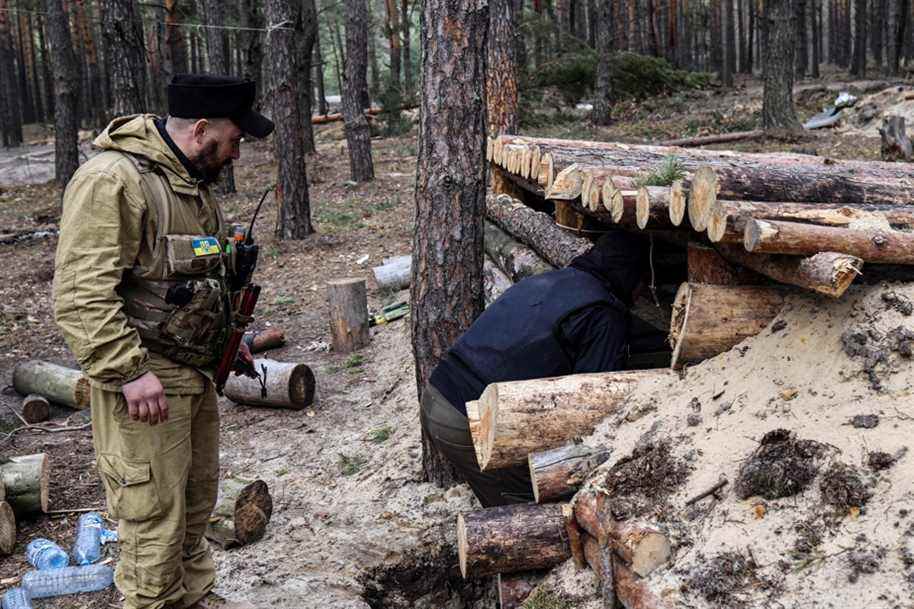(Buda-Babynetska) They were well sheltered under a pine forest, 3 km from the first dwellings, in the middle of the countryside: to the northwest of Kyiv, a thousand Russian soldiers had established a huge base camp.
Posted at 7:12 p.m.
A camp invisible from the long, narrow road through the forest near the village of Buda-Babynetska, located almost 40 km northwest of Kyiv.
Almost invisible also from the sky, thanks to the thick cones at the top of the pines.
The makeshift camp covers an area equivalent to around two football pitches, AFP journalists found.
“There were about 1,000 people stationed there,” according to “Ferrari,” a Ukrainian national guard official in the area, who goes by an alias.
“They arrived there by crossing the border from the direction of Chernobyl,” he told AFP, without being able to give a precise date for the arrival or departure of the soldiers.
Unlike some towns in the region, regularly pounded and destroyed by the violence of the fighting, in this forest where the Russian soldiers lived, there is no trace of destruction by aerial bombardment or artillery.
The camp was spared.

Photo RONALDO SCHEMIDT, Agence France-Presse
US veteran Steven Straub poses for a photo next to a member of the Ukrainian army as they patrol a road near Buda-Babynetska.
“The Ukrainian army mainly hit the places where there were ammunition storages. At this place, there were only staff. It is not right, from the point of view of the Ukrainian army, to bomb if there are only personnel”, justifies “Ferrari”.
The only signs of violence, a white van and a red Lada, riddled with bullet holes, with traces of blood on a door or a seat, abandoned on the side of the road at the edge of the wood.
Their occupants, civilians, were killed as they drove. The bodies were removed recently.

Photo RONALDO SCHEMIDT, Agence France-Presse
A member of the Ukrainian army looks inside a car with bullet holes in the windshield on a road near Buda-Babynetska.
In the forest, the Moscow troops had to be stationed probably for several weeks.
The shelters, of different sizes, depths or widths, were patiently and solidly built.
The ground, a mixture of soft earth and sand, was easy to dig to bury the shelters, at the height of a standing man for the deepest, and a minimum of five feet for the most basic.

Photo RONALDO SCHEMIDT, Agence France-Presse
A trench
Pines were felled, sawn, to make logs used as roofs or walls for shelters.
Other material at hand: hundreds of empty wooden boxes of Grad missiles, with their long planks of about two meters, very practical to shelter from the wind or the rain.
Chapka, ration and gas mask
Many shelters are covered with pine branches.
AFP journalists were able to count more than a hundred shelters of all sizes, scattered in the forest, more or less close to each other.
From the simplest, probably occupied by lookouts, and able to accommodate at least two men, to the largest, certainly those of the troop commanders, who could count at least a dozen places.
Toilets were also built, closed by a blanket or a long cloth, and recognizable by their triangular-shaped roof, made of boneless planks of missile boxes.
Moscow troops withdrew from the Kyiv region in the last days of March.
The occupants of the camp in the forest also had to leave around this time.
“We saw them patrolling so that no one came near” the camp, 15-year-old Bohdan told AFP. He lives 3 km away.
“We approached, we looked for them, and when we saw them walking, we left without them seeing us,” says the teenager.

Photo RONALDO SCHEMIDT, Agence France-Presse
US veteran Steven Straub walks by a Russian armored vehicle as they patrol a road near Buda-Babynetska.
“Every five days or so, we came, we approached to see if they were still there […]. And the last time we came here was the day before yesterday (Sunday), and they weren’t there anymore,” he said. He came with a friend to recover what could be.
Scattered everywhere around or in the shelters, the Russians left empty ration boxes, food wrappers, plastic bottles, stuffed high-top shoes, socks, gloves, a sweater, a shirt, a belt …
Very often, food wrappers were grouped together in rectangular, shallow holes.
Beef, katcha with meat, or rice and meat: individual trays from the rations display the daily menus of the troop.
Rarer, a few khaki or black chapkas, with a star-shaped badge on the front flap, have been abandoned on the ground or in the shelters.
Abandoned also, gas masks, often broken.
In a corner of the camp, on a track, a single military vehicle – a personnel carrier topped with an anti-aircraft gun – was left there, with several of its six wheels punctured.

Photo RONALDO SCHEMIDT, Agence France-Presse
A destroyed armored vehicle
Near a shelter, on the ground, a book in Russian, the wind of which turns the pages soaked by the rain: “48 hours to die”, by the Austrian Andreas Gruber.
Under the title of the cover, a sentence: “The more a criminal tries to cover his tracks, the more clues he leaves”.
